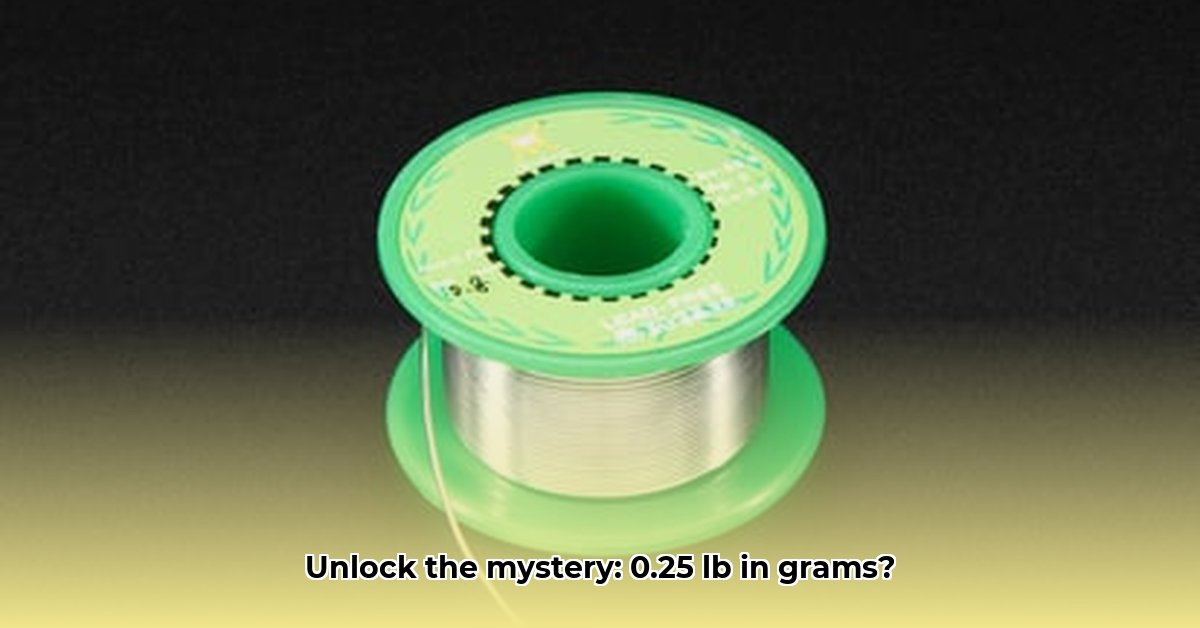
Mastering the Art of Weight Conversion: From Pounds to Grams
Many situations require converting weight measurements between the imperial (pounds) and metric (grams) systems. This guide provides a step-by-step approach to accurately convert 0.25 pounds to grams, emphasizing the importance of precision and context-appropriate rounding. Understanding this conversion is crucial for various applications, from baking to scientific research.
Understanding the Conversion Factor: The Key to Accurate Conversion
The cornerstone of our conversion is the conversion factor: 1 pound (lb) is exactly equal to 453.59237 grams (g). This precise figure stems from internationally agreed-upon definitions, ensuring consistency in weight measurements worldwide. It’s the bridge connecting the two systems and is essential for accurate conversions. Without this precise factor, significant errors can arise, especially in contexts demanding high accuracy like scientific research or engineering.
Step-by-Step Conversion: A Practical Guide
Converting 0.25 pounds to grams involves a straightforward calculation:
- Begin with the Conversion Factor: We know that 1 lb = 453.59237 g.
- Establish the Equation: The conversion equation is: grams = pounds × 453.59237 g/lb
- Substitute the Value: Replace "pounds" with 0.25 lb: grams = 0.25 lb × 453.59237 g/lb
- Calculate the Result: Performing the multiplication yields: grams = 113.3980925 g
Therefore, 0.25 pounds is equal to 113.3980925 grams. However, the number of decimal places to retain depends heavily on the context.
Precision and Rounding: Tailoring Accuracy to the Task
The accuracy required dictates the appropriate number of decimal places to retain. This is where the concept of significant figures becomes important. Significant figures represent the number of digits in a value that contribute to its precision.
Significant Figures and Context:
- Baking a cake: Rounding to 113.4 g or even 113 g is perfectly adequate.
- Precise chemical analysis: Maintaining several decimal places (e.g., 113.3981 g) is essential for accuracy.
- High-precision engineering: Even more decimal places might be necessary (e.g., 113.398093 g) to ensure the necessary level of precision for structural calculations or other vital engineering tasks.
Incorrect rounding can lead to significant errors, particularly in scientific experiments or engineering where even small variations can have major repercussions.
Real-World Applications: Where Precision Matters
Accurate pound-to-gram conversions are vital in various fields:
- Culinary Arts: Baking and cooking recipes often require precise ingredient measurements.
- Shipping and Logistics: Accurate weight calculations are crucial for pricing and efficient transport.
- Scientific Research: Precise measurements are the bedrock of reliable scientific results.
- Pharmaceutical Industry: Accurate dosages are paramount for patient safety.
- Manufacturing and Engineering: Meeting precise weight specifications is critical for product quality and functionality.
Leveraging Online Tools: A Smart Approach
While online conversion tools offer convenience, understanding the underlying calculation remains crucial. These tools can be helpful for quick conversions, but it's essential to understand their potential limitations and to verify the results, especially in high-precision applications. Always double-check the output of online converters against the manual calculation method we described.
Conclusion: Mastering Accuracy in Weight Conversion
Converting 0.25 pounds to grams is a straightforward process – a simple calculation using the conversion factor of 453.59237 grams per pound. However, the true mastery lies in understanding the importance of precision and adapting the level of accuracy to the specific application. This ensures that your conversions are not only correct but also meaningful and relevant to the task at hand. Knowing when and how to appropriately round your result is essential for responsible and effective use of this fundamental conversion.